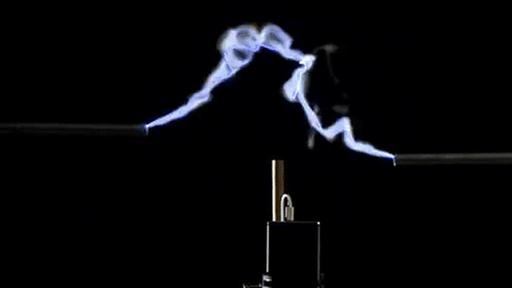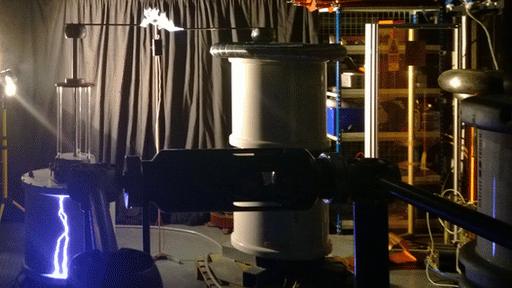Scientists use lightning bolt to charge mobile phone
- Published

The lightning bolt was recreated in the lab
Some 200 years after Mary Shelley used lightning to breathe life into Frankenstein's monster, scientists have copied her idea to power a phone.
The proof-of-concept experiment was conducted at the University of Southampton in collaboration with Nokia.
The mobile firm warned users "not to try this at home".
Harnessing nature in this way could provide power sources where electricity is in short supply, said experts.
Huge step
Using a transformer, the team recreated a lightning bolt in the lab by passing 200,000 volts across a 30cm (12in) air gap.
"We were amazed to see that the Nokia circuitry somehow stabilised the noisy signal, allowing the battery to be charged," said Neil Palmer, from the University of Southampton's high voltage laboratory.

The proof-of-concept experiment is a step towards harnessing the energy from lightning
"This discovery proves devices can be charged with a current that passes through the air, and is a huge step towards understanding a natural power like lightning and harnessing its energy."
Lightning is a discharge of static electricity that occurs when there is an imbalance in the electrical charge between a cloud and the earth's surface.
On average three people die in the UK each year from lightning strikes, according to the Royal Society for the Prevention of Accidents (Rospa).
"We obviously aren't recommending people try this experiment at home, but we are always looking to disrupt and push the boundaries of technology," said Chris Weber, executive vice-president for sales at Nokia.
Finding new ways to charge mobile phones and extend battery life is one of the number one priorities for the mobile industry.
"It's certainly a striking idea," said Ben Wood, of analyst firm CCS Insight.
"Nokia has been among the forerunners of device-charging technology for some time. It's also very committed to caring for the environment. So it's perhaps not surprising that the company's involved in what might appear to be a wacky idea."
He thinks the concept might be useful in areas without reliable electricity.
"If you live in a remote village in India you might welcome the possibility of a communal device that charges phones."
- Published9 August 2013
- Published15 July 2013
- Published20 December 2012